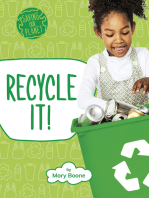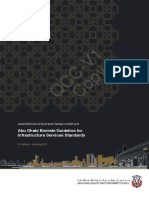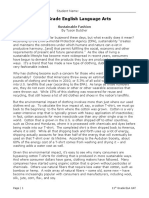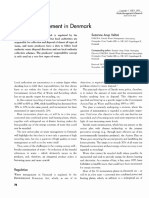Document
Document
Uploaded by
Leslie AbalorioCopyright:
Available Formats
Document
Document
Uploaded by
Leslie AbalorioOriginal Description:
Original Title
Copyright
Available Formats
Share this document
Did you find this document useful?
Is this content inappropriate?
Copyright:
Available Formats
Document
Document
Uploaded by
Leslie AbalorioCopyright:
Available Formats
Problem Based Detailed Lesson Plan in Science 4
Name: Leslie D. Abalorio
Instructor: Cenby Eppie G Gaytos,.Ph.D
Grade Level: 4
Content Standard: Reusing, recycling and reducing will be a giant leap to protect our environment.
I Objectives: After this activity, the students will acquire atleast 85% profrciency level in the following
task:
A. Awareness in economic recycling
B. Recognize the impact of waste recycling to the environment
C. Demonstrate the Safety Precaution in Disposing Waste Matter
II Subject Matter:
Topic: Safety Precaution in Disposing Waste Materials
Reference: https://studylib.net/doc/6873034/problem-based-lesson-plan
Material: Printed Pictures, Visual aid.
III Porcedure
Teachers Activity Students Activity
A. Preliminary Activity
Greetings
Good Morning Class! All: Good morning Maam
Prayer
Before we start our lesson, let is put ourselves
first in the presence of the God, let us pray. Our All: (Praying)
father
…
Checking of the Attendance:
Is there anyone who is absent today? None So far.
B. Motivation
Before we proceed directly to our topic, I
am going to show you some pictures that
are related to our topic.
Are you ready?
(Pictures) All: Yes Maam
Do you know what the pictures are?
What are those Roger? All: Yes Maam
Very Good!
Roger: Those are garbage Maam,
What are we going to do to dispose them
properly?
Yes Thor? All: (Raised their hands)
Very Good.
Thor: Recycle the Recyclable material.
C. Introduction
Okay so,
Recycling is one of the best ways for us
to make a direct impact on the
environment. It helps the environment in a
number of different ways.
How many soft drink cans and plastic
bottles do you or your family use each
week?
All: (Raised their hands)
Yes wanda?
What do you do with the cans when Wanda: 7 cans and 7 plastic in a week.
you’re finished with them?
Yes Toni? All:(Raised their hands)
Okay, Toni: We are throwing them in the garbage bin.
So Garbage contaminates surface of the
earth. It affects all ecosystems existing in
the water, including fish and other animals
that drink the polluted water.
Most of our garbage today is made from
non-biodegradable products such as
plastic, which persists in the marine
environment for potentially thousands of
years
Overflowing garbage can also cause air
pollution, which causes various
respiratory diseases and other adverse
health effects as contaminants are
absorbed from lungs into other parts of the
body
What do you think is the impact of
recycling non biodegradable product in
order to save our environment?
Yes Gamora?
All: (Raised their hands)
Excellent!
What else Racoon?
Gamora: Recycling reduces the need for extracting
(mining, quarrying and logging), refining and
processing raw materials all of which create
substantial air and water pollution.
Very Good.
IV Activity Racoon: As recycling saves energy it also reduces
greenhouse gas emissions, which helps to tackle
So, for our Activity, I will have the class climate change.
form groups of two to solve some waste
problems using a set of facts.
Are you ready?
I will illustrate first the
Facts about Garbage.
There are 365 days in one year.
There are 7 days in one week and 24
hours in one day. There are 52 weeks in All: Yes Maam
one year.
There are 12 months in one year.
There are 16 cups in one gallon.
Recycling one aluminum can saves the
energy equivalent of one cup of gasoline.
Recycling one aluminum can saves
enough energy to light a 100-watt light
bulb for 3.5 hours (210 minutes). Each
person generates about 5 pounds of
garbage per day
-Each pound of aluminum makes 32 cans
These are some example of waste
problems;
The Jones family travels 10 miles to their
favorite amusement park. They use and
recycle 320 cans per year. The Jones’
family car goes 30 miles on every gallon
of gas.
Answer:
320 cans = 320 cups of gasoline saved320
÷ 16 cups/gallon = 20 gallons saved20
gallons X 30 miles/gallon = 600
miles/gallon savedIt’s 10 miles to the
amusement park.600 miles saved X 10
miles each trip = 60 trips
Do you understand?
Very good!
I will distribute a challenge card for each
group, each group will have to work as
team in solving the problem, after solving
the problem, All group members will have
to present their work in front of the class.
Group 1.
A.Suppose your class decides to recycle
cans for a recycling contest. You set a
class goal of 50 cans each week. How
much "gasoline energy" will your class
save each week?
B.Recycling 50 cans each week would
save enough energy to light a room with a
100-watt light bulb for how many
minutes. All: Yes Maam.
Group 2.
A.If you recycle one aluminum can each
day for one year, you would save enough
energy to light a room with a 100-watt
light bulb for how many minutes?
B.Given the number of soda cans you and
your familyuse each week, how many
minutes could you light the light bulb in
one year if they were recycled
Group 1. Answer.
A.1 can saves 1 cup of gas; 50 cans would save
the energy in 50 cups of gas/week
B.50 cups X 210 min. light/cup = 10,500 minutes
(175 hours)
Group 2 Answer
A.365 days X 1 aluminum can/day = 365 cans365
cans X 210 min. light/can = 76,650 minutes
(1,277.5 hours)
B.# cans/week X 52 weeks = # cans/yearcans/year
X 210 min. = # minutes you can light the bulb
You might also like
- Scioly Green Generation NotesDocument2 pagesScioly Green Generation NotesApril Lovely100% (1)
- Detailed-Lesson-Plan-in-Science (Climate Change)Document11 pagesDetailed-Lesson-Plan-in-Science (Climate Change)Joylyn CanastaNo ratings yet
- Lesson Plan in HealthDocument7 pagesLesson Plan in HealthAcess Emanez100% (4)
- A Detailed Lesson Plan in ArtsDocument5 pagesA Detailed Lesson Plan in ArtsJan Lemuel Fortaleza Refuncion100% (1)
- Lesson Plan 7 Handicraft ProductionDocument3 pagesLesson Plan 7 Handicraft ProductionChristine Joy Valencia100% (4)
- WRAP Waste Weights Calculator - Businesses v1 - 0Document11 pagesWRAP Waste Weights Calculator - Businesses v1 - 0childprodigy0% (1)
- 3 Theoretical FrameworkDocument38 pages3 Theoretical FrameworkKimBab100% (1)
- Health6 DLPDocument8 pagesHealth6 DLPAlain IngalNo ratings yet
- Unit 2 Lop 10 GS Practice VocabularyDocument3 pagesUnit 2 Lop 10 GS Practice Vocabularythoaithu2004No ratings yet
- Teacher'S Instruction Learner'S ActivityDocument8 pagesTeacher'S Instruction Learner'S ActivityKrisha Carmille TolentinoNo ratings yet
- Lesson Plan in Mapeh 6Document4 pagesLesson Plan in Mapeh 6Jenz Aria Villa100% (1)
- A Detailed Lesson Plan IntechnologyDocument4 pagesA Detailed Lesson Plan IntechnologyJohn Ellis LacsamanaNo ratings yet
- Detailed - Lesson Plan in HandicraftDocument4 pagesDetailed - Lesson Plan in HandicraftJasmin D. FamaNo ratings yet
- Unit 6 The EnvironmentDocument16 pagesUnit 6 The EnvironmentYoung KIZONo ratings yet
- lesson_plan_on_environmentlevel_intermediateDocument15 pageslesson_plan_on_environmentlevel_intermediateТетяна БойкоNo ratings yet
- DLP AGIngal Health6Document6 pagesDLP AGIngal Health6Alain IngalNo ratings yet
- Co 1 PPT 2023-2024Document33 pagesCo 1 PPT 2023-2024Jessica TamayoNo ratings yet
- Sustainable LifestyleDocument5 pagesSustainable Lifestylevagrace.orzalNo ratings yet
- Ferly Detailed Lesson Plan PpeDocument7 pagesFerly Detailed Lesson Plan PpeFerlizadieflor Fabro De LunasNo ratings yet
- Worksheet A. Match The Questions To The Answers About Climate ChangeDocument6 pagesWorksheet A. Match The Questions To The Answers About Climate ChangeByamba Erdene Nyam OsorNo ratings yet
- Processes of Recycling Waste MaterialsDocument6 pagesProcesses of Recycling Waste MaterialsIvy Serrano100% (1)
- Lesson Plan in Human Impact On The AtmosphereDocument9 pagesLesson Plan in Human Impact On The Atmospheremaryjoy.utbo04No ratings yet
- Exam - CP - 5th - U5 - A1+ Flowers TDocument7 pagesExam - CP - 5th - U5 - A1+ Flowers TJuan Vicente NuñezNo ratings yet
- A Detailed Lesson Plan in ScienceDocument7 pagesA Detailed Lesson Plan in ScienceRheia Tangonan100% (1)
- Resources AlexiaDocument11 pagesResources Alexiaalexia alferezNo ratings yet
- Actividad Ingles GuiaDocument6 pagesActividad Ingles Guiaveronica reina acostaNo ratings yet
- Vienna Science FairDocument6 pagesVienna Science FairFloraNo ratings yet
- The Environment: Answer The Following QuizDocument6 pagesThe Environment: Answer The Following QuizSebastián Chacón SalazarNo ratings yet
- 1final Detailed Lesson Plan in Health 6Document6 pages1final Detailed Lesson Plan in Health 6Kyla Jean AntoqueNo ratings yet
- Name: Nola Aulia Tasya NIM: 2010914120023 Class: A Deapartement Of: PsychologyDocument5 pagesName: Nola Aulia Tasya NIM: 2010914120023 Class: A Deapartement Of: PsychologyDuvi Ahmad Duvi DekanNo ratings yet
- Greenhouse Effect Grand DemoDocument6 pagesGreenhouse Effect Grand DemoKatrinaNo ratings yet
- TOPIK 4. Environment SEMESTER 1Document35 pagesTOPIK 4. Environment SEMESTER 1dinda manggarNo ratings yet
- F2F Iplan Tle 3Document3 pagesF2F Iplan Tle 3SHIELA PANARESNo ratings yet
- Pat Genap KLS 8 2023-2024Document12 pagesPat Genap KLS 8 2023-2024feny risdianaNo ratings yet
- ReportDocument12 pagesReportJulimie AmbagayNo ratings yet
- Detailed Lesson PlanDocument7 pagesDetailed Lesson PlanAlizah Belle Garfin100% (1)
- Lesson Plan in Biology PasaDocument8 pagesLesson Plan in Biology PasaPenelope Soria EjadaNo ratings yet
- Lesson Plan To Ma'Am NecaDocument8 pagesLesson Plan To Ma'Am NecaJeddah CanezaNo ratings yet
- Environmental ProblemsDocument24 pagesEnvironmental ProblemsAndrea Macias100% (1)
- Think GreenDocument22 pagesThink GreenOksana RuslanovnaNo ratings yet
- Climate ChangeDocument9 pagesClimate ChangeTaisy BagonNo ratings yet
- Lesson Plan Grade 7 RecyclingDocument8 pagesLesson Plan Grade 7 RecyclingDiana Marie Pangan NellasNo ratings yet
- Teacher: Nguyen Thi Tuong VyDocument26 pagesTeacher: Nguyen Thi Tuong VyQuynh Thy DoNo ratings yet
- Orator's Club - 3RDocument2 pagesOrator's Club - 3Rgoyal.ruchikaNo ratings yet
- Why do we have to protect the environment?Document6 pagesWhy do we have to protect the environment?Dinh OanhNo ratings yet
- Lesson-Plan-Carbon FootprintDocument7 pagesLesson-Plan-Carbon FootprintGisela GularteNo ratings yet
- Detailed Lesson Plan in Earth ScienceDocument7 pagesDetailed Lesson Plan in Earth ScienceJessica Rosatase Gemang100% (9)
- 7 Q1 Earth ScienceDocument19 pages7 Q1 Earth ScienceleoNo ratings yet
- Phy - Sci. LPDocument13 pagesPhy - Sci. LPGeneveive LiclicanNo ratings yet
- Science Lesson 5Document19 pagesScience Lesson 5CYNTYNo ratings yet
- Expressing Purpose Waste NotDocument2 pagesExpressing Purpose Waste Nottarik sadouki100% (1)
- Unit 8 StsDocument4 pagesUnit 8 StsMaiikol Ortiiz100% (1)
- Istory of Carbon Footprint: "Ecological Footprints"Document24 pagesIstory of Carbon Footprint: "Ecological Footprints"Kunal GuptaNo ratings yet
- Alba Yacar - PAU Do You Think You Can RecycleDocument2 pagesAlba Yacar - PAU Do You Think You Can RecyclealbaNo ratings yet
- DLP in Final DemonstrationDocument10 pagesDLP in Final DemonstrationMisty MamintaNo ratings yet
- Reduce, Reuse, RecycleDocument4 pagesReduce, Reuse, RecycleDayana palomino100% (1)
- Recycling 63140Document2 pagesRecycling 63140marilin05sandobalNo ratings yet
- Sustainable Use of Natural ResourcesDocument47 pagesSustainable Use of Natural Resourcesruna ylananNo ratings yet
- Sav EnvDocument9 pagesSav EnvdikpalakNo ratings yet
- Activity 2:: Reduce, Reuse and Recycle!Document6 pagesActivity 2:: Reduce, Reuse and Recycle!d10168092oNo ratings yet
- Exam - CP - 5th - U5 - A1+ Roots SDocument6 pagesExam - CP - 5th - U5 - A1+ Roots SJuan Vicente NuñezNo ratings yet
- Work Immersion 5SDocument5 pagesWork Immersion 5SABM-A Egamino, Jhon Christian V.No ratings yet
- HSEQ S7 Environmental Posters 2023 V02Document4 pagesHSEQ S7 Environmental Posters 2023 V02Robert PilloraNo ratings yet
- PMT02 PALMERPRO Bedienungsanleitung EN DEDocument2 pagesPMT02 PALMERPRO Bedienungsanleitung EN DE丁海明No ratings yet
- Tuncuk Et Al., 2012 PDFDocument10 pagesTuncuk Et Al., 2012 PDFlaguna028No ratings yet
- Training Plan - Motorcycle Small EngineDocument63 pagesTraining Plan - Motorcycle Small EngineMarc louie Sanchez100% (1)
- RFID TagsDocument255 pagesRFID Tagsdiego83777No ratings yet
- Plastic Recycling: A Greener ApproachDocument62 pagesPlastic Recycling: A Greener ApproachMilica ZozonciNo ratings yet
- MSDS JavacreteDocument5 pagesMSDS JavacretemordanimeNo ratings yet
- IGBC Green Homes Ver1 Precertification Final Review - Century Istana, BangaloreDocument19 pagesIGBC Green Homes Ver1 Precertification Final Review - Century Istana, BangaloreMoloy DasNo ratings yet
- Science SSCDocument6 pagesScience SSCMd Rizwan AhmadNo ratings yet
- Iaea Tecdoc 1000Document54 pagesIaea Tecdoc 1000Larry SuarezNo ratings yet
- Project Report Starting... FinalDocument8 pagesProject Report Starting... FinalyNo ratings yet
- SDS 5960 Jotun Epoxy Filler Comp A Eng CADocument12 pagesSDS 5960 Jotun Epoxy Filler Comp A Eng CAstevenNo ratings yet
- Plastic Water Bottles As Plant PotsDocument3 pagesPlastic Water Bottles As Plant PotsVICTORIA OMEGA JARAMILLANo ratings yet
- SDS - Penguard - Comp. B - Marine - Protective - English (Uk) - United Kingdom - 612 - 01.11.2012Document13 pagesSDS - Penguard - Comp. B - Marine - Protective - English (Uk) - United Kingdom - 612 - 01.11.2012NPTNo ratings yet
- Municipal Waste Management and Recycling WE3 Gender Analysis ReportDocument97 pagesMunicipal Waste Management and Recycling WE3 Gender Analysis ReportJerriza LumanagNo ratings yet
- 08 Gestio I Tractament ResidusDocument38 pages08 Gestio I Tractament ResidusFrancesc Romero GómezNo ratings yet
- AD Guideline Infra Standards PDFDocument156 pagesAD Guideline Infra Standards PDFJavad Akhtar100% (2)
- IntrodutionDocument15 pagesIntrodutionMarwan BNo ratings yet
- Joan Martinez-Alier - The Circularity Gap and The Growth of World Movements For Environmental JusticeDocument7 pagesJoan Martinez-Alier - The Circularity Gap and The Growth of World Movements For Environmental JusticeErnaneNo ratings yet
- End of Life VehiclesDocument69 pagesEnd of Life VehiclesNatasha S.No ratings yet
- 11th Grade Ela CatDocument17 pages11th Grade Ela CatjtNo ratings yet
- Waste Management in Denmark, 1999Document2 pagesWaste Management in Denmark, 1999Kehong SongNo ratings yet
- Masonry NCII Waste Management PlanDocument7 pagesMasonry NCII Waste Management PlanRobinson ConcordiaNo ratings yet
- Students EVS PPTDocument19 pagesStudents EVS PPTheth gadaNo ratings yet
- Municipal Solid Waste To MethanolDocument46 pagesMunicipal Solid Waste To MethanolShehla RiazNo ratings yet
- Produce Recycled MaterialsDocument19 pagesProduce Recycled Materialshermie espirituNo ratings yet

























































































